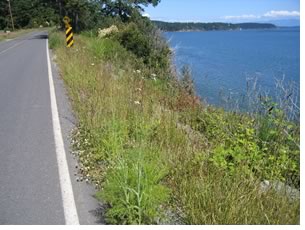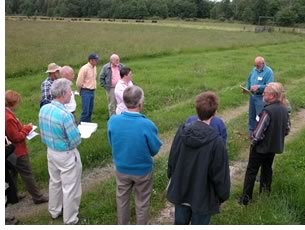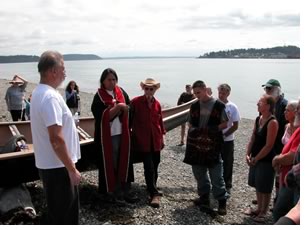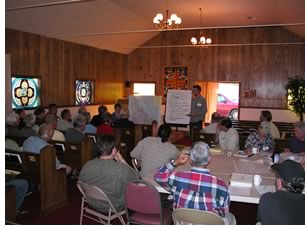

7/2006

by Marj Charlier, freelancer writer, and Ann Livingston, Esq., Director, Center for Communities by Design
 Guemes Island in far northwestern Washington State is the kind of place where people stop in the roadway to chat with a neighbor from the other side of the island they haven’t seen for a week or so. Locals call it “parking in the roadway,” and it’s symptomatic of a rural area where time can stand still long enough for people to catch up on some gossip and where folks don’t need to use turn signals because everyone already knows where they’re going. But small doesn’t ensure accord, and even small changes can be traumatic. “We have a lot of conflict here,” says Al Bush, one of the handful of farmers on the eight-square-mile island.
Guemes Island in far northwestern Washington State is the kind of place where people stop in the roadway to chat with a neighbor from the other side of the island they haven’t seen for a week or so. Locals call it “parking in the roadway,” and it’s symptomatic of a rural area where time can stand still long enough for people to catch up on some gossip and where folks don’t need to use turn signals because everyone already knows where they’re going. But small doesn’t ensure accord, and even small changes can be traumatic. “We have a lot of conflict here,” says Al Bush, one of the handful of farmers on the eight-square-mile island.
Current trends indicate that conditions are likely to get worse.
- With about 70 percent of its shoreline properties in the hands of people 65 and older, and with second-home and retiree demand from the Seattle metro area moving its way, the island faces tremendous change and more conflict.
- Its freshwater aquifer has already started to show its limits with saltwater intrusion at the north end of the island.
- Islanders and the county are in dispute over increasing hours on the island’s ferry, its only access to the mainland.
- Residents are shocked and worried at the $7.5 million price tag on a new home for sale on the beach. “We’re going to get priced off the island,” an islander moaned in public recently, to nods of agreement from fellow residents.
Involving the community
Leaders in the community of 800 fulltime residents wanted to get a handle on these changes and start planning a less contentious and uncertain future. But, as their Skagit County began work on a comprehensive land-use plan, Guemes Island and its concerns weren’t high on the priority list. The island would have to wait some time for assistance with its sub-area plan, the leaders were told.
 “We weren’t really surprised at that,” said Joost Businger, chair of the Guemes Island Planning Advisory Committee (GIPAC). “We just said, ‘Well, we’ll do the work ourselves.’”
“We weren’t really surprised at that,” said Joost Businger, chair of the Guemes Island Planning Advisory Committee (GIPAC). “We just said, ‘Well, we’ll do the work ourselves.’”
GIPAC applied to the AIA Center for Communities by Design for a grant to help it jumpstart its plan with the Center’s Sustainable Design Assessment Team (SDAT) program, and Guemes Island was chosen as one of eight communities to receive technical assistance under the 2006 SDAT program. During the third week of June, a team of architects, landscape architects, water specialists, energy engineers, and transportation experts from around the U.S. arrived to help the island create a plan. Through its charrette process, the SDAT team helped community residents and their planning committee create the blueprint that the island can use for its sub-area plan recommendations to the county’s commissioners.
The SDAT team also reached out to the Samish tribe, the original Native American inhabitants of the island who recently celebrated the 10-year anniversary of the victorious resolution of a long battle with the U.S. Interior Department for recognition of their status. The Samish sent a representative to the public meetings, and several young tribe members paddled by canoe to the island to perform a summer solstice rite in connection with the community gathering. The tribe has a mission to reacquire some tribal lands, a goal that might provide one strategy for protecting open space on the island, observed Erica Gees, AIA, the AIA volunteer team leader for the Guemes project. Gees believes this new relationship can be part of a healing process between the current community and the former inhabitants.
It’s about sustainability
To Gees, the key to bringing people together in planning is SDAT’s focus on sustainability. “When you look at a problem through the sustainability lens, it can bring people with different views together. If you look 100-150 years out, you know no one in the room is going to be around that long. So, it makes it more objective, more visionary, more about community.”
 And, yet, the community also needs some shorter-term projects and milestones to keep the planning process grounded in reality. “You have to find a balance between short-term and long-term recommendations. If you only make ‘visionary’ recommendations that take 10-20 years to have an impact, people will lose interest,” said Gees, an associate with Kuhn Riddle Architects, Amherst, Mass. “You have to have proposals that have a short-term impact to keep the momentum going.”
And, yet, the community also needs some shorter-term projects and milestones to keep the planning process grounded in reality. “You have to find a balance between short-term and long-term recommendations. If you only make ‘visionary’ recommendations that take 10-20 years to have an impact, people will lose interest,” said Gees, an associate with Kuhn Riddle Architects, Amherst, Mass. “You have to have proposals that have a short-term impact to keep the momentum going.”
The Guemes Island SDAT involved about 60 community stakeholders who discussed five areas of interest. Following the roundtable discussions, the AIA team members prepared findings and recommendations, including some short-term strategies and long-term policies in the five areas delineated by the island leaders:
- Preserve the island’s rural character
- Conserve water and protect the quality of the island’s sole source aquifer
- Resolve transportation disagreements
- Protect wildlife and shoreline habitats
- Increase island energy independence.
 “One of the things that really impressed me was how many different voices and people who often disagree were brought together in this process,” said Edith Walden, an orchard owner on Guemes Island, a local businesswoman, and one of the roundtable participants. “Having all their input has made us all aware that we do have a community with a common vision. It’s made us all energized and hopeful about our future.”
“One of the things that really impressed me was how many different voices and people who often disagree were brought together in this process,” said Edith Walden, an orchard owner on Guemes Island, a local businesswoman, and one of the roundtable participants. “Having all their input has made us all aware that we do have a community with a common vision. It’s made us all energized and hopeful about our future.”
Is it working?
The SDAT process received kudos from islanders at the end of the week—as much for its ability to bring people together as for its recommendations. In all, 188 people out of the 800 full-time residents showed up for the meetings. “I thought it was as inclusive a process as I’ve ever seen,” said Bob Groeschell, a part-time resident who works at Seattle Community College during the week. “As someone who’s only been on the island for three years, I felt my voice mattered as much as everyone else’s. I found it energizing.”
And Al Bush, the farmer, was also hopeful that the process taught the island new ways to work with its estranged county government. The SDAT team “tried to suggest ways of amending that conflict,” he said. “I’m willing to put my shoulder to the wheel and make this work. It’s wrong to fight with people we put into office. We must find a middle ground and put things back in balance and heal the wounds with our government. This is a process that we can build on.”
For the county, too, the SDAT process seemed to break a logjam. Steve Cox, the county’s director of the Guemes Island Ferry, had declined to meet with the SDAT team during their scoping visit in the spring because he was so weary of the conflict with the islanders. But for the SDAT charrette, county officials, including Cox, returned to the island, and were impressed enough to not only pledge to come back to the table to talk over the issues, but also to ask for SDAT help with other sub-area plans within the county.
“I’m proud that we have brought a process to the table that will allow the county and its residents to get back together and work out their conflicts,” said Gees.
Copyright 2006 The American Institute of Architects.
All rights reserved. Home Page ![]()
![]()
To read the daily updates that were posted during the Guemes Island SDAT, visit the Communities by Design Web site.
The SDAT Process
The SDAT process starts each year with a request for proposals from communities—among other criteria, the application must have the support of the local AIA component. An expert panel selects communities to receive SDAT assistance from among those who apply. An AIA Center for Communities by Design staff member and the SDAT team leader visit the community to size up the project and determine what kind of a team is needed to help.
The actual SDAT process starts with a community tour for the SDAT team, preliminary set of roundtable meetings with community stakeholders, and a public meeting to discuss the project and gather additional community input. Another full day of roundtable meetings with residents is followed by an intense work session by the team, who pull together their recommendations. A final public meeting is held to present the recommendations and solicit feedback. A report is prepared for distribution to the community, and then, over the following year, the SDAT team members and AIA staff provide additional consultation as needed. After a year, select team members will revisit the community to provide more guidance. For more information on the Center for Communities by Design’s Design Assistance programs, including the SDAT and R/UDAT programs, visit the SDAT Web site.
![]()